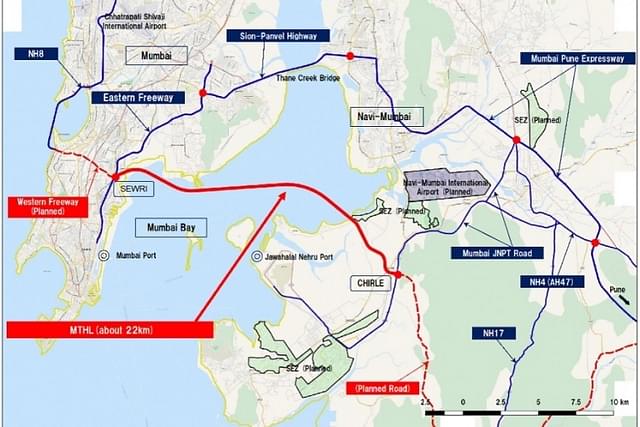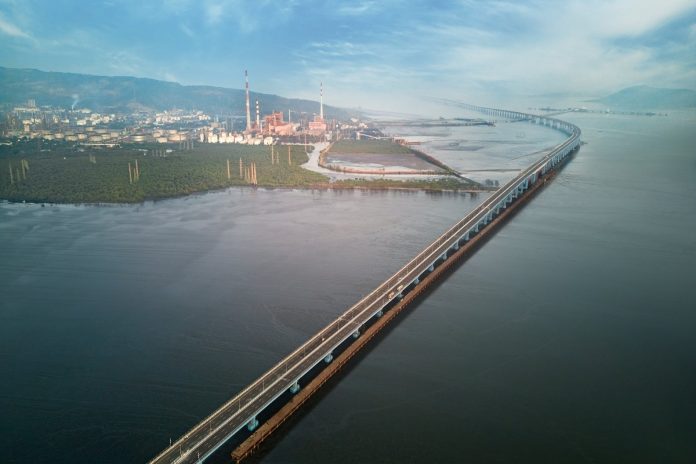Prime Minister Narendra Modi is set to inaugurate the Mumbai Trans-Harbour Link (MTHL), marking a historic milestone as India’s longest bridge over sea.
Financed by the Japan International Cooperation Agency (JICA), the MTHL Bridge is a 22-km-long six-lane marine road bridge implemented by the Mumbai Metropolitan Region Development Authority (MMRDA).
This marvel, first conceptualised six decades ago, is poised to redefine connectivity and significantly reduce travel time in the Mumbai Metropolitan Region.
Named as the Atal Bihari Vajpayee Sewri-Nhava Sheva Atal Setu, in honour of the late former prime minister Atal Bihari Vajpayee, the project seamlessly links Sewri in Mumbai to Chirle in Navi Mumbai, Maharashtra.
India’s Longest Sea Bridge
The project includes constructing a six-lane viaduct spanning Mumbai Bay, consisting of 0.5 km of land viaduct at Sewri, 16.3 km over sea and creek, and 4.9 km on the Navi Mumbai side.
Starting from Messant Road in Sewri, connecting with the Eastern Freeway, it concludes at Shivaji Nagar in Navi Mumbai, offering a seamless 20-minute commute without traffic signals.
This fully controlled-access highway features four interchanges, toll collection facilities, and necessary infrastructure for safe and efficient operation, conforming to expressway standards with a design speed of 100 km per hour.

An Engineering Marvel: A Feat Of Modern Ingenuity
The Mumbai Trans-Harbour Link project showcases cutting-edge technology, boasting a 100-year lifespan and constructed with advanced Japanese technology.
Notably, it introduces Orthotropic Steel Deck spans (OSD), ranging from 65 to 180 metres — a pioneering feat in India according to the MMRDA.
The innovative OSD, a first-time use in the country, enhances load-carrying capacity more efficiently than a concrete superstructure. Its prefabrication reduces on-site work, contributing to a shorter construction period and lower safety risks, minimising environmental impact.
The bridge’s lighting poles are resilient to deep-sea challenges, featuring a corrosion-free polyurethane coating, galvanisation for rust prevention, and a structural design capable of withstanding high winds.
Equipped with a lightning protection system, these poles ensure durability against potential damage from lightning strikes.
Additional features include an automated toll collection system and an intelligent transport system, enhancing the overall efficiency and technological prowess of the Mumbai Trans-Harbour Link.
Record-Breaking Pace Of Construction — Six Years
In 2017, the initiative gained momentum as the MMRDA entered into a partnership with the JICA.
This collaboration involves financial support through a development loan to the tune of Rs 18,000 crore. Subsequently, construction activities for the project commenced in April 2018, after finalising the tendering process in December 2017.
The MTHL bridge work was split into four packages — while packages 1 and 2 are sea-based, package 3 is on land.
On 4 January 2022, the first OSD for MTHL was launched. On 9 May 2023, the final OSD for the MTHL was successfully launched.
How Atal Setu Overcame Cost Escalation And Other Challenges
Constructing the bridge posed numerous challenges for the state, ranging from the impact of the Covid-19 pandemic to acquiring equipment and securing environmental clearances to protect mangroves and the habitat of migratory flamingos.
Transporting massive girders weighing between 700 and 2,600 metric tonnes presented a significant challenge in the project.
To overcome this, a strategic sea-based cement batching plant was innovatively implemented, ensuring concrete quality and eliminating the need for lengthy land transportation, reducing travel time from 8-9 hours to minutes.
Engaging a workforce of over 5,000 individuals daily since mid-2018, the project witnessed relentless efforts to bring it to fruition.
Navigating the muddy waters of Thane Creek posed challenges in constructing tall pillars supporting the girders. To address this, engineers employed an unconventional approach, mapping soil conditions around each pillar and conducting thorough seabed investigations at both Sewri and Chirle ends, reports Hindustan Times.
Special drilling methods were utilised, cutting six times deeper into the bedrock to safeguard pillar strength and holding capacity. Facing tough rocks that chipped off drilling machine cutters, workers adopted a unique technique, digging ahead of a designated mudflat area to minimise soil collapse risks.
Delays induced by the COVID-19 pandemic led to a cost escalation of Rs 2,192 crore, equivalent to 14.9 per cent, as per information from a Right to Information (RTI) query by activist Anil Galgali.
The original cost of Rs 14,712.70 crore increased to Rs 16,904.43 crore due to setbacks caused by pandemic-induced lockdowns.
Impact On Mumbai’s Connectivity And Economy
Once operational, the MTHL is anticipated to witness a daily traffic volume of 39,300 vehicles traveling between the Sewri and Shivaji Nagar interchange, with an additional 9,800 vehicles commuting between the Shivaji Nagar and Chirle interchange.
The bridge is designed to accommodate 70,000 vehicles daily, the bridge is poised to significantly cut the travel distance from South Mumbai to Chirle by approximately 30 km. The crossing, taking a mere 16 minutes, is expected to save commuters at least an hour of travel time.
The positive environmental impact of the MTHL is noteworthy, with projections indicating the potential saving of one crore litres of fuel annually and a significant reduction in pollution levels.
This reduction is estimated to be approximately 25,680 metric tonnes less of CO2 emissions, underscoring the bridge’s contribution to sustainability and environmental well-being.
Described as a transformative initiative, its successful implementation has the potential to elevate the state’s gross domestic product (GDP) by 5 per cent and contribute to 1 per cent increase in the national GDP, as highlighted by Dr Sanjay Mukherjee, Commissioner of MMRDA.


